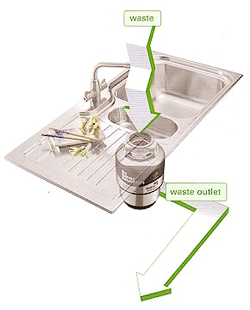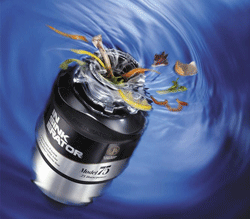Relatively unknown in South Africa, the waste disposal unit under the kitchen sink is very popular in the USA, Australia, New Zealand and getting more and more popular in the UK and Europe at large. It was invented in 1927 by American inventor, John W. Hammes. By 1938, he was selling the "Insinkerator" throughout the USA. The garbage disposal unit, however, only really became very popular in the homes of the more affluent people in the '70s and early '80s.
 How they work
How they workWaste disposal units come in a variety of different styles, however, all of the units work according to the same principle: they are fitted beneath the kitchen sink in line with the waste water pipe to receive any organic waste matter. The waste matter is chopped up by small shredding or cutting blades that are operated electrically. They reduce the waste into a paste like consistency so that it can be carried by the water through the drain pipes and into the main sewer system. The unit will dispose of most types of food stuffs hygienically and efficiently, cancelling the need for over-filled bins, which end up stinking because of foodstuffs that have putrefied. Waste disposal systems have become a well admired modern day aid in well-equipped kitchens around the world.
Operating the unit
 Most waste disposal units are operated by a switch on the wall or kitchen surface near to the sink. When using the unit, always have the cold water tap running so the waste can easily be washed down the drain. Do not run hot water through the system, as it will melt fats which could solidify later on, causing blockages. Once you have finished feeding your organic waste into the unit, allow it to run for a few minutes to ensure all the waste has been disposed of. Most of the units have a reverse switch to be used when the blades get jammed. Run the machine in reverse for two minutes and that should clear any blockage. If this does not work, you can unclip the motor and clear it out by hand. A sure way to damage the unit is to try and put glass and other inorganic materials into the machine. Most of the garbage disposal units today can handle bones as well, but to be on the safe side, it is advisable to rather throw the bones in the bin or give them to your dogs.
Most waste disposal units are operated by a switch on the wall or kitchen surface near to the sink. When using the unit, always have the cold water tap running so the waste can easily be washed down the drain. Do not run hot water through the system, as it will melt fats which could solidify later on, causing blockages. Once you have finished feeding your organic waste into the unit, allow it to run for a few minutes to ensure all the waste has been disposed of. Most of the units have a reverse switch to be used when the blades get jammed. Run the machine in reverse for two minutes and that should clear any blockage. If this does not work, you can unclip the motor and clear it out by hand. A sure way to damage the unit is to try and put glass and other inorganic materials into the machine. Most of the garbage disposal units today can handle bones as well, but to be on the safe side, it is advisable to rather throw the bones in the bin or give them to your dogs.Installing a waste disposal unit
 If you have decided to get a waste disposer for your kitchen, ensure that the sink is made from a solid and strong material, such as stainless steel for example, as the units are heavy and tend to vibrate while they are operating. Also check the area beneath the sink to ensure there is enough room for the motor. The waste disposer can be fitted into most homes that are connected to the main sewerage system, but those homes that have French drains or septic tanks should not consider this as an option, as the ground waste could block up the system. If the sink is fitted with the bottle trap outlet, have it replaced with the U-bend outlet as this will cope better with the volume of waste material used.
If you have decided to get a waste disposer for your kitchen, ensure that the sink is made from a solid and strong material, such as stainless steel for example, as the units are heavy and tend to vibrate while they are operating. Also check the area beneath the sink to ensure there is enough room for the motor. The waste disposer can be fitted into most homes that are connected to the main sewerage system, but those homes that have French drains or septic tanks should not consider this as an option, as the ground waste could block up the system. If the sink is fitted with the bottle trap outlet, have it replaced with the U-bend outlet as this will cope better with the volume of waste material used.The pipes beneath the sink need to be removed before the unit can be installed. The old sink bush needs to be taken out so the bush that attaches to the waste disposer can be fitted. Before fitting the new bush, seal the area with silicone to prevent any leaking. The waste disposer consists of the upper and lower parts. Once the bush has been screwed on, the upper housing can be fitted. This also needs to be connected to the waste pipe. Once you have connected the unit to the waste pipe, the bottom half of the machine can be attached. As the waste pipe is now in a different position you will probably have to chop a new hole into the outside wall to get the pipe to the drain. If you have an open drain, present in many older homes, ensure that the waste pipe goes into the drain and below the surface of the water. This will prevent any unpleasant odours escaping. For most of us who are not handymen, it would be wise at this point to get an electrician in to wire up the system. Once this is done you are ready for action.
This system will force you to use a little more water than normal; however, it is very hygienic, efficient, simple to operate and an absolute pleasure to have in your kitchen. – Antonella Dési
Pictures
Images courtesy of:
- Bautec
- H2O International
- In-Sink-Erator
- Waste Disposals
For more information click here to visit the Bautec website.
For more information click here to visit the H2O International website.
For more information click here to visit the In-Sink-Erator website.
For more information click here to visit the Waste Disposals website.
Property News
Click here for more property news articles.
Need a blog?
Start your own blog with a free blog from 24.com.








